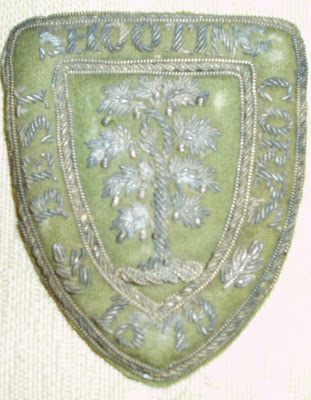Trenton Evening Times - June 30, 1906
Involvement in one organization was apparently not sufficient as early in 1904, James was installed as "shepherd" and "trustee" of the Independent Order of Shepherds, Alpha Lodge No 1. No explanation of the additional commitment survives, but since this organization was co-ed, it may have been a place for father-daughter activity, much like the masons provided father and son opportunities. Whatever the reason, only six months later, James was elevated to vice-chairman of what the Trenton Evening News called "one of the best lodges in the city." James did other things with his daughters such as attending an Order of the Eastern Star meeting where he "gave a fitting and appreciated oration" which was followed by some "beautiful soul searching music" by daughter Elsie.
Elsie Winder
Trenton Evening Times - October 19, 1902
Music also continued to play an important part in James' life as he was reported as singing at his and Mary's silver anniversary celebration and at a Shepherd's meeting. James had also not forgotten the benefits he received as a young man from the Worcester School of Art. Only about 15 months before his death, a list of 63 of the "most prominent gentlemen in the city" attending a dinner supporting the Trenton School of the Arts included James R. Winder. Although the Winder family wasn't getting rich from the Delaware Pottery Company, they had at least enough money to make some small real estate investments in late 1906 and early 1907. Of these the largest was a project to build a nine unit housing project on Swenson Avenue near Hermitage Avenue in Trenton. James' partners in this project were another English immigrant family, general contractor James Proctor and his son, Samuel.
The "cakewalk" - a minstrel dance reportedly performed at James and Mary's 25th wedding anniversary
The aforementioned real estate project was not the first nor the most important Winder-Proctor partnership. In the early years of the 20th century, James William Winder and Mary Elizabeth Proctor fell in love and were married on October 14, 1903. This is perhaps, symbolic of the coming of age of all four Winder children during the family's first twenty years in Trenton. By 1910 even Florence, the baby of the family, was married and out on her own. James W and Elsie had long working careers outside the home, Elsie as a music teacher and James ultimately as a carpenter at C. V. Hills, a Trenton refrigerator manufacturer. Edith and Florence both married and had three and six children respectively between them. By 1910 James had six grandchildren with seven to come that he would never know.
As 1910 dawned did James have any sense his life was drawing to a close. Certainly everyone in the family was reminded of their mortality when James' mother died in February after 10 years in Trenton. Obviously there is no way to know the answer, but the fact that James had been treated for heart disease suggests he had to have known all was not well. Equally clearly, however, James and his family began that fateful day as if it were an ordinary Saturday.
James and Mary Winder's grave - Riverview Cemetery in Trenton
What, if anything, did he think about in those last minutes and hours? We can only hope he had a sense of satisfaction about how well he had used what must have seemed like a short 53 plus years. Rising from very humble beginnings, James became a skilled craftsman and served his community while starting and providing for a family in England. Having done all that once, he and his wife had the courage and faith to move more than 3000 miles and start over, making a better life, not only for their children, but for all of us who are fortunate enough to be their descendants. Many of his gifts and interests, like music and fraternal orders continue among us today over a century after his death. James R. Winder may not have had the longest life, but no one can question that he used his time wisely and well.
































